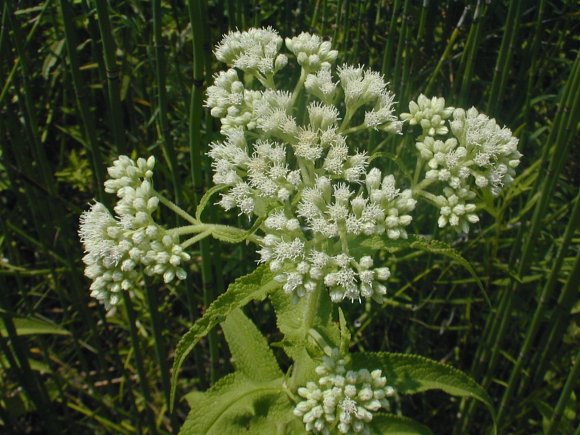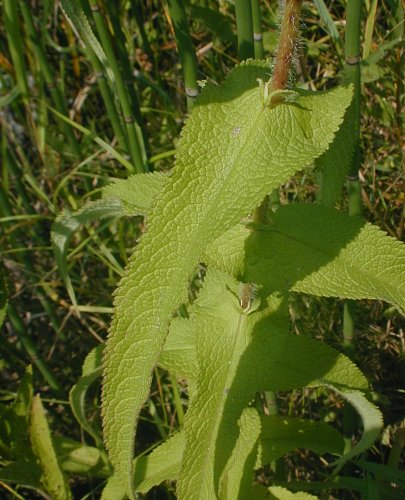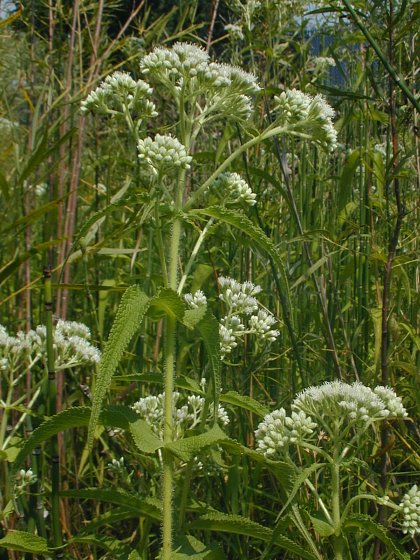Description: This perennial plant is 2-4' tall and unbranched, except for some flowering side stems near the apex. The central stem and side stems are covered with long white hairs. The opposite leaves are up to 8" long and 2" across, and light or yellowish green. Their bases surround the central stem and merge together (perfoliate). In shape, they are lanceolate with long narrow tips and serrate margins. There is a conspicuous network of veins, particularly on the lower leaf surface. This lower surface is also pubescent. Some of the upper leaves near the inflorescence(s) are much smaller in size and sessile. The upper stems terminate in clusters of white flowerheads, spanning about 2-8" across. Each flowerhead is about 1/6" (4 mm.) across and consists of about 15 disk florets. Each disk floret has 5 spreading lobes and a long divided style, in the manner of other Eupatorium spp. The blooming period is late summer to early fall, which typically lasts about 1-2 months for a colony of plants. There is a pleasant floral scent. The florets are replaced by achenes with small tufts of hair – they are dispersed by the wind. The root system is fibrous and produces rhizomes in abundance. Common Boneset typically forms vegetative colonies.

Cultivation:
The preference is full or partial sun, and wet to moist conditions. The
soil should contain considerable organic material so that it can retain
moisture. This plant can withstand flooded conditions for short periods
of time, but it is not really aquatic. The foliage appears to be little
bothered by pests and disease.
Range & Habitat:
The native Common Boneset has been reported from most counties of
Illinois, and it is
fairly common (see Distribution
Map). However, this plant appears to be somewhat less common
than
either Eupatorium serotinum (Late Boneset) and Eupatorium
altissimum (Tall Boneset). Habitats include openings in
floodplain forests, poorly drained areas of black soil prairies, and
various kinds of wetlands, including marshes, bogs, fens,
seeps, edges of rivers, and sand flats along Lake Michigan. This plant
also occurs in or near roadside ditches. Generally, it doesn't stray
far from wetland areas of one kind or another.

Faunal Associations: The nectar or pollen of the flowers attracts many kinds of insects, including bees, flies, wasps, butterflies, and beetles. In particular, many kinds of unusual flies and wasps are attracted to the flowers because of the accessibility of the nectar. The caterpillars of various moth species are known to feed on various parts of Common Boneset, including Haploa clymene (Clymene Moth), Phragmatobia lineata (Lined Ruby Tiger Moth), Papaipema cataphracta (Burdock Borer Moth), Schinia trifascia (Three-Lined Flower Moth), Chlorochlamys chloroleucaria (Blackberry Looper Moth), and Semiothisa continuata (Geometrid Moth sp.). The small seeds appear to be of little interest to birds and other fauna, although they are occasionally eaten by the Swamp Sparrow. Mammalian herbivores display little interest in Common Boneset as a food source because of the bitterness of the foliage.

Photographic
Location:
The photographed plants were growing at the bottom of a drainage ditch
amid horsetails near the Windsor Road Prairie in Champaign, Illinois.
This portion of the drainage ditch does not have standing water during
dry weather (i.e., a seasonal wetland).
Comments:
Common Boneset has interesting foliage and fragrant flowers. It
tolerates flooded conditions better than many other Boneset species. It
can be distinghished from these other species by the perfoliate leaves
that surround the central stem. The other species have opposite leaves
that are sessile or have distinct petioles. All of these species have
spreading clusters of white flowers with a similar appearance. These
flowers are quite popular with diverse kinds of insects.